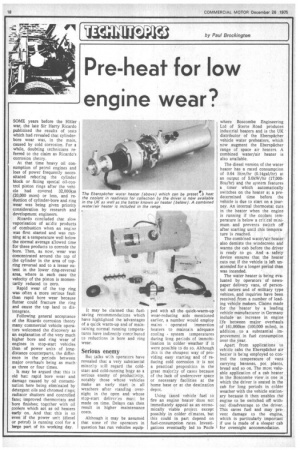Pre-heat for low engine wear?
Page 20

If you've noticed an error in this article please click here to report it so we can fix it.
SOME years before the Hitler war, the late Sir Harry Ricardo publicised the results of tests which had revealed that cylinderbore wear was, in the main, caused by cold corrosion. For a doubting technicians referred to the claim as Ricardo's corrosion theory.
At that time heavy oil consumption of petrol engines and loss of power frequently necessitated rebor:ng the cylinder block or flitting special oil-control piston rings after the vehicle had covered 32,000km (20,000 rn,ies) or less, and reduction of cylinder-bore and ring wear was being given priority consideration by research and development engineers.
Ricardo concluded that slow vaporisation of ac:clic products Of combustion when an engine was first started and was running at a temperature well below the normal average elawed time for these products to corrode the bore. Then, as now, wear was concentrated around the top of the cylinder in the area of topring reversal and to a lesser extent in the lower ring-reversal area, where in each case the velocity of the piston is momentarily reduced to zero.
Rapid wear of the top ring was often a more serious fault than rapid bore wear because flutter could fracture the ring and cause the tap land to disintegrate.
Following general acceptance of the Ricardo corrosion theory many commercial vehicle operators welcomed the discovery as an explanation of the very much higher bore and ring wear of engines in stop-start vehicles than elf power units of longdistance counterparts, the difference in the periods between major overhauls being as much' as three or four times.
lit may be argued that this is old hat: rapid bore wear and damage caused by oil contamination here being eliminated by detergent oils and chromed rings; radiator shutters and controlled fans; improved thermostats and bore finishes; together with oil coolers which act as oil heaters early on. And that this is so even if the power unit (diesel or petrol) is running cool for a large part. of its working day.
It may be claimed that fuelsaving recommendations which have highlighted the advantages of a quick warm-up and of maintaining normal running temperatures have indirectly contr.buted to reductions in bore and ring wear.
Serious enemy
But talks with operators have revealed that a very substantial minor:ty still regard the coldstart and cold-running bogy as a serious enemy of productivity, notably those whose vehicles make an early start in all weathers after standing overnight in the open and whose stop-start deliver:es mus: be made on time. Delays can then result in higher maintenance costs.
Although it may be assumed that none of the operators in question has run vehicles equip ped with all the quick-warm-up wear-reducing aids mentioned earlier, a number would employ mains operated immersion heaters to maintain adequate cooling system temperatures during long periads of immobilisation in colder weather if it were possible to do so. Although his is the cheapest way of providing easy starting and cf reducing cold corrosion it is not a practical proposition in the great majority of cases because cf the lack of undercover space or necessary facilities at the home base or at the destination depot.
Using taxed vehicle fuel to fire an engine heater does not immediately appeal as an economically viable project except possibly in colder &mates, but this could in part depend on fuel-consumption rates. Investigations eventually led to Poole where Boscombe Engineering Ltd of Sterte Road produces industrial heaters and is the UK distributor of the Eberspacher vehicle water preheaters, which now augment the Eberspacher range of space air heaters. A combined water/air heater is also available.
The diesel version of the water heater has a rated consumption of 0.64 litre/hr (0.14gal/hr) at an output of 5.0kW/hr (17,000Btu/hr) and the system features a timer which automatically switches on the heater at a predetermined time before the vehicle is due to start an a journey. An infernal thermostat cuts in the heater when the engine is running if the coolant temperature is below a critical minimum and prevents switch off after starting until this tempera. ture is reached.
The combined waterier heater also demists the windscreen and warms the cab before the driver is ready to go. And a •safety device ensures that the heater cuts out if the vehicle is left unattended for a longer period than was intended.
The water heater is being evaluated by operators of newspaper delivery vans, of personnel cariers and of military type vehices, and inquiries have been received from a number of leading vehicle makers. Claims made for the heater by a leading vehicle manufacturer in Germany include an increase in engine life between major overhauls of 161,000km (100,000 miles), in addition to a substantial improvement in fuel consumption over the year.
Apart from applications to vehicle cabs the Eberspacher air heater is being employed to control the temperature of vans carrying bananas, pot plants, bread and so on. The most valuable application of a cab heater in the Boscombe view is one in which the driver is seated in the cab for long periods in colder weather with the vehicle stationary because it then enables the engine to be switched off without disadvantage to the driver. This saves fuel and may prevent damage to 'the engine, which particularly important if use is made of a sleeper cab for overnight acc,ommodation.




















































